Waveless Picking
Sweetens Bottom Line
Overview
A waveless picking and warehouse automation project for 165 year-old premium quality chocolate producer Lindt & Sprüngli put MSI Automate’s Fasttrak® warehouse software and control systems at the heart of the company’s new distribution center in Stratham, New Hampshire.
The waveless picking and warehouse automation system included a Pick-to-Light system, extensive conveyor systems, a sortation system with a sliding shoe sorter (aka slat sorter), and MSI Automate’s own Warehouse Execution Software (WES), Warehouse Control System (WCS), and Warehouse Management System (WMS) software. MSI Automate’s software enabled a seamless integration with Lindt’s JD Edwards business system for inventory allocation against orders and lot tracking. And MSI Automate’s visualization software provided a central monitoring system enabling complete visibility of the overall system and the individual component performance.
At a rated speed of over 100 parcels per minute, the MSI Automate-directed waveless picking and warehouse automation system enabled a five-fold increase in Lindt’s business, while reducing processing costs and labor requirements across the board.
Video Overview
Situation
With six production sites in Europe, two in the U.S., and distribution and sales on four continents, Chocoladefabriken Lindt & Sprüngli AG has been long recognized as a leader in the market for premium quality chocolate. Offering a large selection of products in more than 100 countries around the world, Lindt & Sprüngli is also known as one of the most innovative and creative companies making premium chocolate.
Lindt’s success in the U.S. had brought it to the point that its old distribution center was bursting at the seams. The facilities production capabilities were not keeping pace with the rest of the industry, and the company was also having problems meeting wholesaler/retailer compliance labeling demands.
Opportunity
In order for Lindt to continue growing in the U.S., the company mandated that a new distribution center be built adjacent to their manufacturing facility in Stratham, New Hampshire. In laying out the specs for a new distribution center, Lindt focused on several key cost considerations:
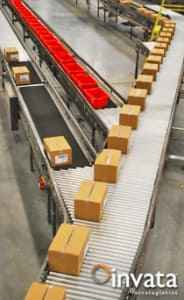
An extensive conveyor network enables hands free material handling.
- Lindt was committed to utilizing its JD Edwards enterprise software, but needed some way to fill the gaps in its business system when it came to the Warehouse Management System (WMS) and Warehouse Control System (WCS) needed to optimize a warehouse automation system utilizing material handling subsystems, conveyor systems, and sortation systems.
- The company needed to find a way to comply with looming governmental regulations for tracking the identity of production lots to wholesale clients without bringing the distribution center to its knees.
- Lindt needed to expand its ability to meet wholesaler/retailer compliance labeling requirements, as the company’s existing manual approach had become very costly and back charges for non-compliance had gotten out of control.
- The company wanted to find ways to minimize labor and production costs associated with its distribution operation.
- Lindt wanted to dramatically enhance its distribution center productivity standards, which had fallen below established industry best practices at that point.
That’s when the team from MSI Automate was tasked with designing and integrating a waveless picking system incorporating the latest in warehouse automation technology that could act as the backbone for the new facility.
Waveless Picking Solution
In creating a new waveless picking system for Lindt, the MSI Automate team not only automated the movement of materials within the distribution center, they also automated the flow of data, eliminating what had been a costly and cumbersome manual data collection process.
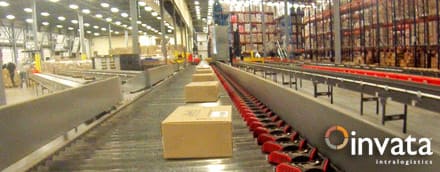
A sliding shoe sorter dynamically feeds 11 pallet building stations.
The distribution center design features the following material handling systems:
- a dynamic pick line for cases and totes, incorporating Pick-to-Light modules for quantity and lot verification
- a print and apply labeling system, incorporating 4 printer applicators run by round robin algorithm
- a sliding shoe sortation system with 11 sorter lanes, 1 exceptions processing lane, and 1 recirculation lane
- an extensive network of conveyors, including 12 different types of conveyor
- a paperless pallet building system, using digital display boards to director palletizing activities
The distribution center design capabilities include:
-
waveless picking/selection
production lot control identification, control, and tracking - wholesaler/retailer compliance labeling
- real-time control of the material handling equipment
-
system wide information flow
high visibility of operations and data - the warehouse management system and warehouse control system functionality needed to fill gaps left by Lindt’s ERP

All goods in the storage and retrieval area are inventoried by lot number and handled in a FEFO manner for tracking throughout the distribution process.
The system works in the following manner: When manufacturing is complete, pallets of manufactured product are moved to the warehouse via a pallet conveyor. Pallets are then moved into an extensive storage and retrieval area where they are handled in a first expired first out (FEFO) sequence. All items are inventoried by lot number for traceability through the distribution center, onto outbound pallets, and ultimately to the wholesale customer.
The order fulfillment process is initiated by the JD Edwards host software which organizes orders and associated replenishments for the dynamic pick line. MSI Automate’s warehouse software then manages the entire waveless picking process as well as the mixed item pallet-building process used to ready items for shipment. There are 54 pick locations and 11 loading lanes. MSI Automate’s Warehouse Control System software (WCS) manages the use of available equipment and labor resources to ensure everything comes together in an optimal manner, minimizing labor demand, and ensuring accuracy in order fulfillment.
Pick-to-light displays are utilized for a pick-to-belt process, wherein operators pick cases from pallet bays, loading them onto a conveyor. To begin the order selection process, the pick-to-light display first indicates the lot number that is supposed to be in a given location. The operator checks for a match. If that number is correct, the operator presses a button and the pick quantity is then displayed and order selection begins.
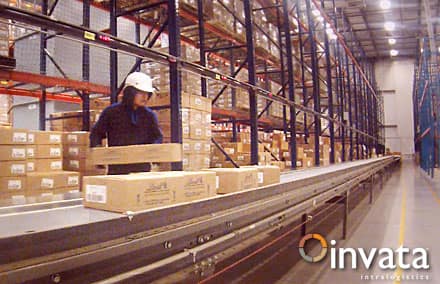
54 Pick-to-Light displays direct a pick-to-belt order selection process.
To eliminate potential operator errors in losing track of the carton count when picking larger quantities, the PTL display is restricted to indicating a maximum quantity of 10 items. When the operator reaches a 10 count, the PTL display button must be pushed to get the next pick quantity. This enables pickers to fill multiple orders simultaneously, while maintaining strict quality control.
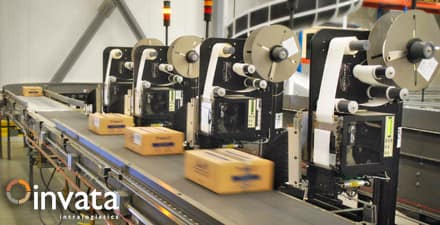
Round robin algorithms direct four printer/applicators in meeting compliance labeling requirements of select wholesale clients.
Cases on route to palletizing are automatically conveyed through a series of alignment conveyors and merges, and then through the print/apply labeling system where labels are selectively applied to those cases going to clients requiring compliance labeling. This eliminates the manual approach to compliance labeling that Lindt previously used.
MSI Automate’s warehouse software uses the bar codes on the cases to identify the item and lot number of each approaching parcel and then allocates the inventory to orders, records the lot, and print/applies the correctly formatted compliance label.
Once cases arrive on the outbound sliding shoe sorter, shoes are assigned to each case and sortation lanes are allocated for the order/pallet building process. The lane allocation is a dynamic process, which doesn’t require fixed waves. This waveless picking system enables Lindt to optimize the use of their system, while accommodating variability in pallet quantity and individual productivity.
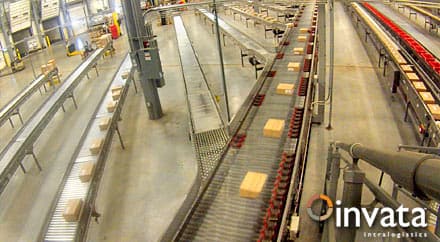
Shipping lane assignments are dynamically allocated to the sliding shoe sorter through a waveless picking system.
The shoes on the sorter slide gently across the conveyor, positively diverting each case into the post sort lane.
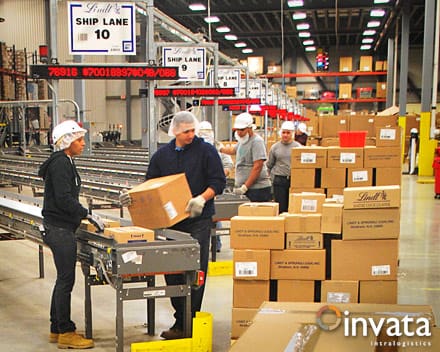
Compliance labelled cases are sorted to paperless pallet building stations that utilize reader boards to direct final order staging.
At the end of the post sort lanes, a “reader board” indicates the order number that is active on that lane as well as the quantity of cases to be expected for that order. Next to the expected quantity, the reader board displays an arrived quantity as well. This allows the operators palletizing the orders to easily see when an order is complete and to track down any items that may have ended up in the exceptions processing lane.
Once an order/pallet is complete, it is wrapped, labeled, and staged for loading.
In keeping with MSI Automate’s longstanding tradition of providing top tier support for its distribution center design and warehouse automation systems, Lindt now has a waveless picking and warehouse automation system that is fully supportable on a remote basis: Through a combination of pcAnywhere, MS-SQL database tools, and PLC programming software accessed via a high-speed VPN connection, MSI Automate is able to remotely troubleshoot issues working with client personnel on-site on a 24/7/365 basis.
The system also allows MSI Automate to remotely install software updates, analyze logs and trace files, analyze and backup databases, troubleshoot and reconfigure peripheral devices, and examine the programmable logic controller as well as connected devices.
Waveless Picking System Results
Thanks to distribution center design and warehouse automation expertise, Lindt achieved its goals of building a new distribution center that enabled it to keep pace with expect growth, keep compliant with both government regulations and client labeling demands, and make the most of their JD Edwards business software without having to buy a dedicated WMS system. The distribution center has enabled a five-fold increase in Lindt’s business.

A waveless picking system by the FastTrak team at MSI Automate enables best practice handling of this pallet of Lindt Chocolates on route through the automated distribution center.
By automating their warehouse with innovative technology directed by MSI Automate’s warehouse software, Lindt successfully completed a major system expansion that is helping to minimize costs while making the company a leader in delivering quality via industry best practices.
